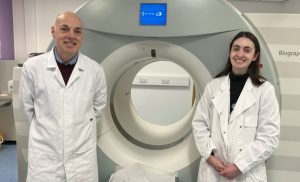
Researchers who have created a new tool that could transform medical understanding of inflammation – a feature of most diseases – have received £2m to test it in humans.
The new Positron Emission Tomography (PET) radiotracer LW223 is the first to be unaffected by the rs6971 polymorphism – a genetic mutation in humans that has so far limited the efficacy of inflammation imaging to around 40% of the population.
PET scanning involves injecting tiny amounts of radioactive compounds, called radiotracers, into the body to transmit signals to an extremely sensitive camera, allowing clinicians to better assess symptoms of disease.
As inflammation is present in multiple conditions – including heart attacks, strokes, brain tumours and cancers – being able to view it effectively is crucial for the diagnosis, prognosis and treatment of most diseases.
The LW223 tracer contains fluoride as the radioactive element which, with a physical half-life of about two hours, can be transported between medical sites, making it immediately clinically and commercially viable in a way that other radioactive elements, such as Carbon-11, are not.
Following successful trials to date in human tissue, a team at the University of Edinburgh, working with the University of Glasgow and industry partner Life Molecular Imaging (LMI), has now received £2m from the Medical Research Council’s Developmental Pathway Funding Scheme to test the LW223 radiotracer in healthy volunteers and in patients who have had a heart attack.
Lead researcher Dr Adriana Tavares, from the University of Edinburgh’s Centre for Cardiovascular Science, said: “This is the first fluorinated PET tracer in 40 years that seems to be able to bind to the human translocator protein (TSPO) – an indicator of inflammation - independently of the rs6971 polymorphism, a mutation present in around 60 per cent of the world’s population.
“This LW223 radiotracer shows really strong potential to be able to scan all of the human population and examine inflammation inside organs like the heart or brain. This will be extremely important for disease diagnosis, for understanding whether a treatment is working, and for drug development. Ultimately, it will save lives.”
Currently, blood tests give only indirect information about what is happening inside an organ, and biopsies are invasive and can give false negatives.
Dr Tavares continued:
Our studies to date also show that the reading of the PET images collected following administration of LW223 is simpler than with other radiotracers, making it easier for clinicians to use.”
Dr Tavares’ team carried out biological testing and in-vivo analysis of LW223, while Professor Andrew Sutherland and his School of Chemistry team from Glasgow designed, synthesised and performed physical and chemical studies of the molecule.
Professor Sutherland said:
We have been seeking a radionuclide tracer of TSPO for nearly 15 years, with setbacks due to polymorphism sensitivity, so it is really exciting to be working on the development of a compound that has overcome this major issue and shows real potential as an imaging agent of inflammation.”
The team have financial and in-kind backing from an industry partner, Life Molecular Imaging (LMI), and have been supported by Edinburgh Innovations, the University’s commercialisation service, and by the University of Glasgow’s Research and Innovation Services.
Dr Andrew Stephens, Chief Medical Officer at LMI, said:
We are very excited to be part of this research programme. Inflammation is a key process of major diseases like Alzheimer’s, cancer and cardiovascular disease. TSPO is a validated target. However, previous radiotracers have had limitations. The preclinical data of LW223 look very promising, and we are very keen to see this compound translated into the clinical setting to further validate a new radiotracer for broad applications.”
The joint team patented the LW223 radiotracer in 2019, and their published data won an Editor’s Choice Award in the Journal of Nuclear Medicine. Read the paper in the Journal of Nuclear Medicine.
Header Image: Professor Andy Sutherland and Dr Adriana Tavares with a patient scanner at the Queen’s Medical Research Institute, Edinburgh